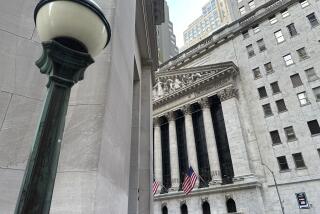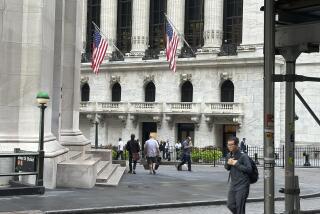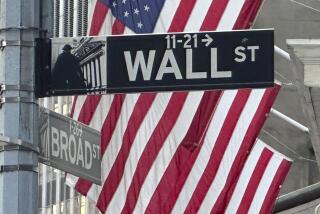Another T-Bond Barrier Falls : Markets: Long-term yields drop to 5.94% after a government report shows an unexpected fall in jobs. Stocks inch up.
The yield on the Treasury’s benchmark long-term bond tumbled below 6% on Friday for the first time in its history, as a weak August employment report helped spark frenzied buying of fixed-rate securities.
Investors, fearing that a languishing economy may mean still-lower interest rates in the months ahead, rushed to lock in long-term yields that haven’t been this low since the early-1970s.
The stock market, meanwhile, managed to struggle higher, but analysts warned that the economy’s troubles could put at least a temporary crimp in the bull market. The Dow Jones industrials rose 7.83 points to 3,633.93.
Most investors, in any case, were focused on the bond market. The yield on the Treasury’s 30-year issue plummeted from 6.04% on Thursday to 5.94% at Friday’s close, slicing through the 6% mark with relative ease.
The new yield was the lowest on the bond since the Treasury began selling 30-year issues regularly in 1977 and is down from 7.39% at the start of this year.
Experts say long-term interest rates in general now are at their lowest levels since about 1972. And they note that each new decline in Treasury bond yields has broad ramifications--pulling corporate borrowing costs down further and shaving mortgage rates for homeowners and potential home buyers.
The speed with which bond yields have plunged this summer has taken Wall Street by surprise. Analysts say the drop has been fueled by the economy’s sluggishness--which translates into a lack of demand for money--and also by growing panic on the part of thousands of bond fund managers, many of whom had doubted they would see 6% long-term yields in their lifetimes.
With each slide in rates, more bond pros have been forced to grab for the best yields they can find, or risk appearing inept to clients several months from now should rates be far lower, analysts say.
Indeed, some experts said Friday that the August employment report, while disappointing because it showed a 39,000-job drop in the nation’s non-farm payroll, was stronger than it appeared. But that did not dissuade investors from pouring into the bond market again.
Also, for the first time since spring, some analysts suggested Friday that the Federal Reserve Board could be forced to cut short-term interest rates to help the economy--even though short rates already are at 30-year lows.
“Certainly, the bond market has Fed-ease fever,” said Stephen Slifer, chief financial market economist at Lehman Bros. in New York.
But Slifer and many other economists insist the economy is in better shape than it looks and that another reduction in short rates isn’t likely. Still, even if short rates stay level, bond yields could fall further given the market’s momentum, experts say.
Although speculators are helping to drive the market, Slifer said there is legitimate demand for bonds from mutual funds and other longer-term investors who have until now resisted the rally.
In the stock market, meanwhile, the good news on rates was barely enough to overcome worries about the weak economy’s potential effect on corporate profits.
Besides the August jobs report, stock investors were confronted with news that the government’s index of leading economic indicators fell 0.1% in July, erasing June’s slight gain.
The Dow industrials’ minuscule gain was mirrored elsewhere in the market, where trading was slow in advance of the long Labor Day weekend. Financial markets will be closed Monday.
Nonetheless, winners topped losers 10 to 9 on the Big Board. And the NASDAQ composite index of mostly smaller stocks edged up 1.06 points to 749.71--its fifth consecutive record.
Though an uninspired economy suggests companies’ earnings may not meet expectations, analysts say many investors will feel compelled to simply stay put in stocks. The reason: The latest slide in interest rates further reduces the attraction of bonds and other fixed-income investments compared to stocks.
Among the market highlights:
* Interest-rate-sensitive stocks led the market. Bond insurer MBIA jumped 2 1/8 to 79 1/8, J.P. Morgan rose 1 7/8 to 77 1/4 and Countrywide Credit surged 1 3/8 to 30 1/4.
* Despite the weak economic backdrop, some industrial stocks advanced. PPG Industries rose 1 to 68 1/2, Alcoa surged 1 3/8 to 74 3/8, Scott Paper advanced 7/8 to 34 1/8 and Deere gained 7/8 to 68 5/8. But auto stocks were weak.
* On NASDAQ, communications issues again led. IDB Communications soared 1 3/4 to 53 1/2, Dial Page zoomed 3 3/4 to 40 and Broadband Technology leaped 2 1/2 to 43.
* Among the losers, drug stocks’ recent rebound ran out of gas. Merck eased 1/4 to 32 7/8, Johnson & Johnson lost 1 to 39 7/8 and Warner-Lambert gave up 1 1/8 to 70 1/8.
Overseas, London’s FTSE-100 index fell 15.3 points to 3,057.3, and Frankfurt’s DAX index slipped 0.46 point to 1,925.16. In Paris, the CAC-40 index sank 29.03 points to 2,156.09 in heavy profit taking.
But in Tokyo, the Nikkei index set a new closing high for 1993, up 133.01 points to 21,116.21 on active buying by foreign investors.
Other Markets
The dollar plunged to its lowest closing level against the German mark in nearly three months after the Labor Department’s employment report convinced investors that U.S. interest rates will remain lower than those abroad.
The dollar’s decline was exaggerated by the thinness of the market before the long weekend.
In New York, the dollar closed at 1.622 German marks, down from 1.643 on Thursday. It also fell to 104.60 yen, down from 105.90.
Gold prices edged up after Thursday’s tumble. Near-term futures closed at $364.50 an ounce on the Comex, up 90 cents. But silver fell 4.7 cents to $4.52.
Oil futures resumed their slide on the New York Merc on new signs of OPEC overproduction. Near-term futures fell 24 cents to $17.73 a barrel.
Market Roundup, D4
Breaking 6%
The 30-year Treasury bond yield fell below 6% Friday for the first time since the bonds were issued in 1977.
30-year T-bond yield, biweekly: Sept. 11, 1992: 7.29% Friday: 5.94% Source: Reuters
More to Read
Inside the business of entertainment
The Wide Shot brings you news, analysis and insights on everything from streaming wars to production — and what it all means for the future.
You may occasionally receive promotional content from the Los Angeles Times.










